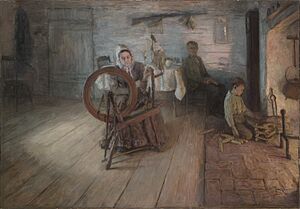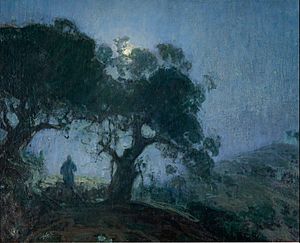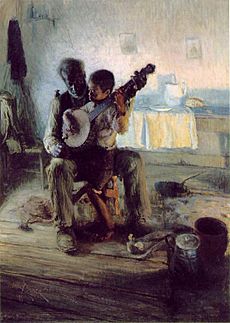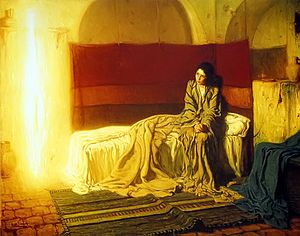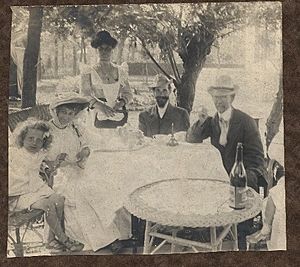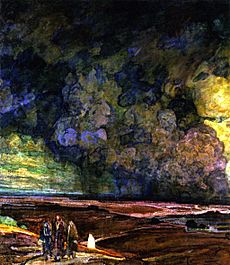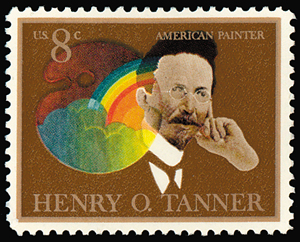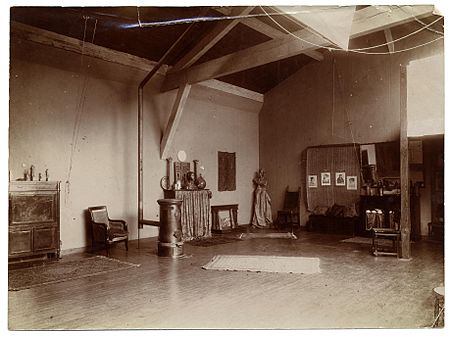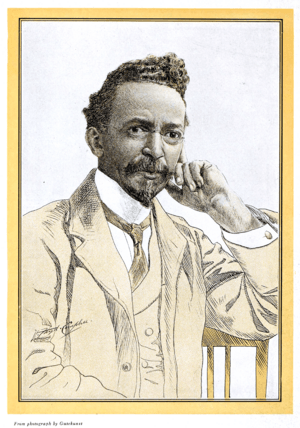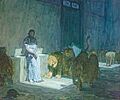Henry Ossawa Tanner facts for kids
Quick facts for kids
Henry Ossawa Tanner
|
|
|---|---|

Henry Ossawa Tanner in 1907 by Frederick Gutekunst
|
|
| Born |
Henry Ossawa Tanner
June 21, 1859 |
| Died | May 25, 1937 (aged 77) |
| Nationality | American |
| Known for | Painting, drawing |
Henry Ossawa Tanner (born June 21, 1859 – died May 25, 1937) was an American artist. He was the first African-American painter to become famous around the world. In 1891, Tanner moved to Paris, France, to study art. He stayed there for most of his life after being welcomed by French artists. His painting called Daniel in the Lions' Den was shown at the 1896 Salon. This was a very important art show in Paris.
When he was young, Tanner taught himself a lot about art. In 1879, he joined the Pennsylvania Academy of the Fine Arts in Philadelphia. He was the only Black student there. He became a favorite student of the painter Thomas Eakins, who had just started teaching. Tanner also met other artists, like Robert Henri. In the late 1890s, a man named Rodman Wanamaker paid for Tanner to visit the Mutasarrifate of Jerusalem. Wanamaker was very impressed by Tanner's paintings of stories from the Bible.
Contents
Henry Tanner's Early Life
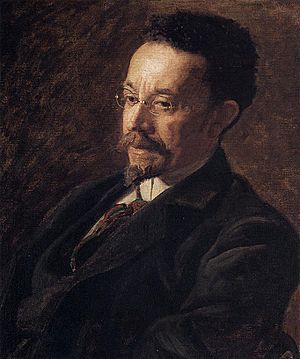
Henry Tanner was born in Pittsburgh, Pennsylvania. He was the first of nine children. His middle name, Ossawa, honored a fight against slavery at Osawatomie. His father, Benjamin Tucker Tanner, was a bishop in the African Methodist Episcopal Church. This was the first independent Black church in the United States. His father was also a writer and a social activist. Henry's mother, Sarah Tanner, was born into slavery in Virginia. She escaped to the North using the Underground Railroad.
When Henry was young, his family moved to Philadelphia. His father became friends with Frederick Douglass there. When Henry was about 13, he decided he wanted to be a painter. This happened after he saw a landscape painter working in Fairmount Park.
Tanner's Art Education
Many art teachers did not want to take a Black student. But in 1879, Tanner joined the Pennsylvania Academy of the Fine Arts in Philadelphia. He was the only Black student there. This was an exciting time for art schools. Art academies used to focus only on copying plaster statues and learning anatomy from books.
This changed a lot when Thomas Eakins became a professor at the Academy. Eakins encouraged new ways of learning. Students studied from live models and discussed anatomy openly. They even dissected bodies to understand the human form better. Eakins's new ideas greatly influenced Tanner. Tanner became one of Eakins's favorite students. Twenty years after Tanner left, Eakins painted his portrait, which was a great honor.
At the Academy, Tanner became friends with other artists. He stayed in touch with them for the rest of his life. One important friend was Robert Henri, who helped start the Ashcan School. In a short time at the Academy, Tanner learned a lot about anatomy. He became skilled at showing the weight and structure of the human body in his paintings.
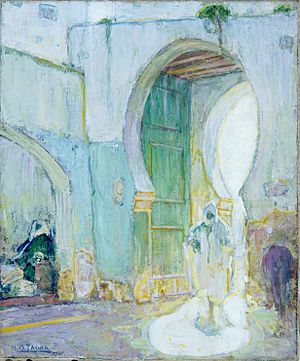
Life as an Artist Abroad
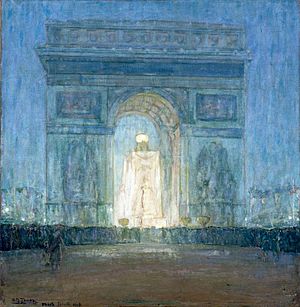
In the late 1880s, Tanner tried to open a photography studio in Atlanta. He hoped to earn enough money to travel to Europe, but the business did not do well. During this time, Tanner met Bishop Joseph Crane Hartzell. Hartzell and his wife became Tanner's supporters. They helped him get a teaching job at Clark College (now Clark Atlanta University). Tanner taught drawing there for a short time.
In 1891, he traveled to Paris, France, to study at the Académie Julian. He also joined the American Art Students Club. Paris was a welcome change for Tanner. In French art groups, a person's race did not matter much. Tanner quickly got used to life in Paris. Except for short visits home, he lived there for the rest of his life.
In Paris, he met many new artists whose work changed his painting style. At the Louvre museum, he studied paintings by Gustave Courbet, Jean-Baptiste Chardin, and Louis Le Nain. These artists painted scenes of everyday people. Their influence can be seen in Tanner's work. For example, Courbet's The Stone Breakers (1850) is similar to Tanner's The Young Sabot Maker (1895). Both paintings show people doing manual labor.
Tanner studied with famous artists like Jean Joseph Benjamin Constant and Jean-Paul Laurens. With their help, Tanner started to become well-known. He settled in an art community called Étaples art colony in Normandy. At first, Tanner painted scenes of people struggling with the sea. But by 1895, he mostly painted religious works. This change happened as he was going through a spiritual journey. He wrote to his parents in 1896, saying he wanted to "serve Him [God] more faithfully." A painting from this time, The Good Shepherd, shows a fishing boat on stormy waves.
This painting is based on a story from the Gospel of Matthew. It describes a miracle where "the boat was now in the middle of the sea, tossed by the waves, for the wind was contrary." The simple setting of Étaples fit his new subjects well. Many of his religious paintings showed Bible figures in dark rooms.
His painting Daniel in the Lions' Den was accepted into the 1896 Salon. Later that year, he painted The Resurrection of Lazarus. Critics praised this painting, which made Tanner a respected artist. It also showed the future direction of his art, which would mostly be biblical themes. After seeing The Resurrection of Lazarus, art critic Rodman Wanamaker offered to pay for Tanner to travel to the Middle East. Wanamaker believed that any serious painter of Bible scenes needed to see the places firsthand.
Tanner quickly accepted the offer. He traveled to the Palestine region in the Levant. He explored mosques and Bible sites. He also studied the local people. This trip helped Tanner improve his art even more. His paintings gained a strong sense of mystery and spirituality. Tanner was not the first artist to visit the Middle East. Since the 1830s, interest in Orientalism had grown in Europe. Artists like Eugène Delacroix and David Roberts also made such trips.
In 1923, France gave Tanner one of its highest honors. He was made a Chevalier of the Legion of Honor. This is the highest national award in France. Tanner said this award was "the greatest honor of his illustrious career."
The Banjo Lesson Painting
In 1893, Tanner made a short visit back to the United States. While in Philadelphia, he painted his most famous work, The Banjo Lesson. The painting shows an older Black man teaching a boy, probably his grandson, how to play the banjo. This painting looks simple but explores important ideas.
Black people were often shown as entertainers in American culture. Images of Black men playing the banjo were common in late 19th-century American art. Artists like Thomas Worth, Willy Miller, and Tanner's teacher Thomas Eakins had painted this subject.
These images often showed Black people in a disrespectful way, like minstrel show characters. Tanner painted a thoughtful and sensitive version. Instead of a general idea, his painting shows a real moment between two people. The man and boy are focused on playing the banjo. They seem unaware of anything else, which makes their connection feel very real. The detailed portraits show that these are real individuals, not just types.
Besides being a meaningful painting, it is also painted very skillfully. Tanner used soft colors to create a peaceful scene. This emphasizes modesty and family. There are two different light sources in the painting. A cool, white-blue light comes from outside on the left. A warm light from a fireplace is on the right. The figures are lit where these two lights meet. Some people think this shows Tanner's own situation, being between two worlds: his American past and his new home in France.
Henry Tanner's Painting Style
Tanner is often seen as a realist painter. This means he focused on showing subjects exactly as they looked. While paintings like The Banjo Lesson showed everyday life for African Americans, Tanner later painted mostly religious themes. He is best known for these works today. It is likely that his father, a minister, greatly influenced him.
Tanner's art includes different ways of painting and drawing. Some of his paintings show great detail, while others have loose, expressive brushstrokes. Often, he used both methods at the same time. Tanner also cared about how colors affected a painting. Many of his works highlight a specific range of colors.
Warm paintings like The Resurrection of Lazarus (1896) and The Annunciation (1898) show the strong feelings of religious moments. They express the joy of a connection between God and humans. Other paintings use cool colors, which became common in his work after the mid-1890s. Colors like indigo and turquoise, sometimes called "Tanner blues," are seen in works like The Three Marys (1910) and The Arch (1919). Paintings such as The Good Shepherd (1903) and Return of the Holy Women (1904) create a feeling of quiet religious thought.
Tanner often experimented with light in his paintings. The source and strength of light and shadow create a real, almost touchable space and mood. Tanner also used light to add symbolic meaning. In The Annunciation (1898), the angel Gabriel is shown as a column of light. This light, along with a shelf, forms a cross. This shows Mary's acceptance of her role, which includes the challenges she would face.
Marriage and Family Life
In 1899, Henry Tanner married Jessie Olsson, who was a Swedish-American opera singer. Jessie Tanner passed away in 1925, twelve years before her husband. He was very sad after her death. He sold their family home in Les Charmes, where they had been very happy. They are buried next to each other in Sceaux, France. They had one son named Jesse, who was still alive when Tanner died.
Later Years and Legacy
During World War I, Tanner worked for the Red Cross. He painted scenes from the war front. His paintings showing African-American soldiers were rare during that time. In 1923, the French government made him a knight of the Legion of Honour for his art.
Around 1927, Tanner met another African-American artist, Palmer Hayden, in Paris. They talked about art techniques, and Tanner gave Hayden advice on living in French society.
Some of Tanner's paintings were bought by J. J. Haverty, an art collector from Atlanta. Haverty helped start the High Museum of Art. Tanner's Étaples Fisher Folk is now part of the High Museum's collection.
Henry Ossawa Tanner died peacefully at his home in Paris, France, on May 25, 1937. He is buried in Sceaux, a suburb of Paris.
Tanner's Artistic Legacy
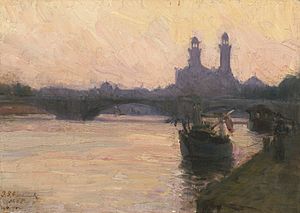
Tanner's work was very important during his career. He has been called "the greatest African American painter to date." The early paintings of William Edouard Scott, who studied with Tanner in France, show Tanner's influence. Also, some of Norman Rockwell's illustrations deal with similar themes and compositions. For example, Rockwell's proposed cover for Literary Digest in 1922 shows an older Black man playing the banjo for his grandson. The light sources are almost the same as in Tanner's Banjo Lesson. A fireplace lights the right side, and natural light comes from the left. Both artists also used similar objects, like clothing and a crumpled hat on the floor. Tanner also guided other major artists, including William A. Harper and Hale Woodruff.
Tanner's painting Sand Dunes at Sunset, Atlantic City (c. 1885) hangs in the Green Room at the White House. It was the first painting by an African-American artist to be bought for the White House's permanent collection. The painting shows a landscape with "a view across the cool gray of a shadowed beach to dunes made pink by the late afternoon sunlight. A low haze over the water partially hides the sun." It was bought for $100,000 during the Bill Clinton administration.
Art Exhibitions
- 1972. The Art of Henry Ossawa Tanner. Glen Falls, New York: The Hyde Collection.
- 1972. 19th Century American Landscape. New York: Metropolitan Museum of Art.
- 1976. Two Centuries of Black American Art. Los Angeles County Museum of Art.
- 1989. Black Art Ancestral Legacy: The African Impulse in African-American Art. Dallas Museum of Art.
- 1993. Revisiting the White City: American Art at the 1893 World's Fair
- 2010. Henry Ossawa Tanner and his Contemporaries, Des Moines Art Center (December–February 2011).
- 2012. Henry Ossawa Tanner: Modern Spirit, Pennsylvania Academy of the Fine Arts, Philadelphia (January–April), then to Cincinnati Art Museum (May–September) and to Houston Museum of Fine Arts (October–January 2013)
Selected Artworks
- Seascape-Jetty (c.1876–78)
- Pomp at the Zoo (1880). Private Collection
- Joachim Leaving the Temple (c. 1882-1888). Baltimore Museum of Art
- Sand Dunes at Sunset, Atlantic City (1886). Estate of Sadie T. M. Alexander (On permanent display at the White House)
- The Banjo Lesson (1893). Hampton University Museum, Virginia
- The Thankful Poor (1894). William H. and Camille O. Cosby
- The Young Sabot Maker (1895). The Nelson-Atkins Museum of Art, Kansas City, Missouri
- Daniel in the Lions' Den (1895). Los Angeles County Museum of Art
- The Resurrection of Lazarus (1896). Musée d'Orsay, Paris
- Bishop Benjamin Tucker Tanner (1897). Baltimore Museum of Art
- Lions in the Desert (c. 1897–1900). Smithsonian American Art Museum
- The Annunciation (1898). Philadelphia Museum of Art, W.P. Wilstach Collection
- Moonlight Landscape (1898-1900). Muscarelle Museum of Art, Williamsburg, VA.
- Boy and Sheep Lying under a Tree (1881). Private Collection (On display at the Philadelphia Museum of Art)
- The Good Shepherd (1903). Jane Voorhees Zimmerli Art Museum, Rutgers University
- Return of the Holy Women (1904). Cedar Rapids Art Gallery, Iowa
- Two Disciples at the Tomb (1905–06). Art Institute of Chicago
- The Holy Family (1909–10). Muskegon Museum of Art, Michigan, Hackley Picture Fund
- Moroccan Scene (about 1912). Birmingham Museum of Art, Alabama
- Palace of Justice, Tangier (1912–13). Smithsonian American Art Museum
- Scene in Cairo. Mabee-Gerrer Museum of Art, Shawnee, Oklahoma
Images for kids
-
Sand Dunes at Sunset, Atlantic City, c. 1885, the White House.
-
Destruction of Sodom and Gomorrah, 1929–30, High Museum of Art
See also
 In Spanish: Henry Ossawa Tanner para niños
In Spanish: Henry Ossawa Tanner para niños


